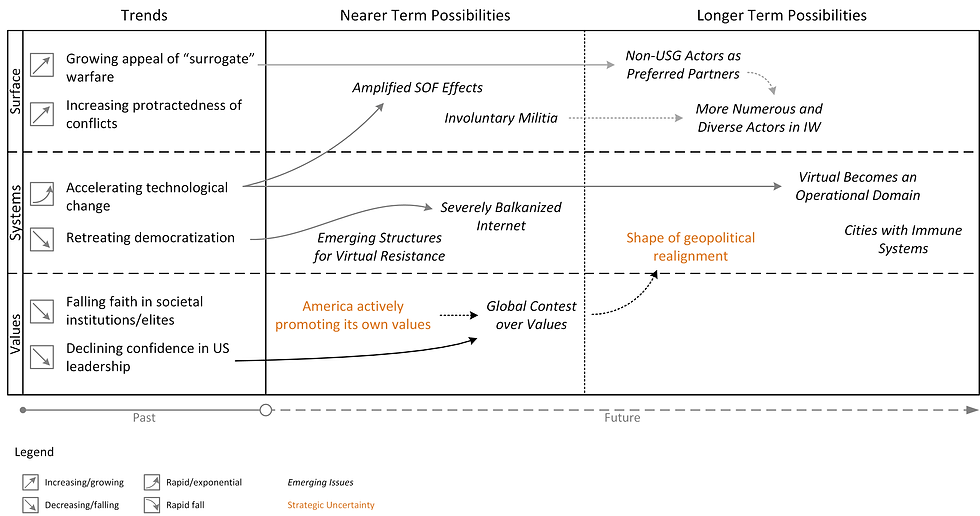The Simple Organizational Benefits of Foresight Training
- Richard Lum

- Apr 18, 2022
- 4 min read
Bottom Line: foresight training transforms scattered staff insights into a shared organizational understanding of emerging threats and opportunities.

Introduction
While a fair number of writers and commentators disparage foresight as misguided or overhyped attempts to predict the future, in fact, foresight is best understood as insight into how and why the future could be different from the present. It is a form of insight. It goes without saying that organizations benefit from having more insight, not less. Foresight training, when coupled with a few simple organizational tweaks, can significantly improve an organization’s ability to detect potential changes in the environment, think critically about what those changes represent, and change how teams discuss and communicate insights across the organization.
Detecting Signals of Change
The world today is awash in indicators of change. The lines of technological change continue to multiply, from digital fabrication to synthetic biology to a nascent space economy. From gig work to the sharing economy to social media “influencers”, the number of individuals engaged in diverse small business efforts continues to grow. Geopolitics is shifting, the climate is changing, and society continues to go through its present political and social turmoil. Today, there are so many potential vectors of change that you immediately get drowned in the hourly deluge of press releases, news articles, and blog posts.
Fortunately, every organization has its own network of sensors to filter and collect these signals of change. While organizations have always relied on their staff to point out issues or opportunities, today it is more important than ever to make the best use of staff as a smart, distributed network of detectors of change. Foresight training supercharges this natural system by teaching individuals what to look for in the environment and where to look for signals of change. Training gives staff the practices they need, such as emerging issues analysis, to recognize and categorize the changes in the environment they are seeing. With the right training, individuals learn how to judge when it is too early vs too late to call everyone’s attention to that recent article on experimental AI that can create drawings to your request.
Making Sense of Signals of Change
Foresight training also provides new mental models and conceptual frameworks for handling these multiplying signals of change. At the heart of futures work is better understanding of how and why change happens in society. The field, therefore, has a variety of models for organizing and assessing signals of change for the future opportunities or threats they represent. For example, the foresight variant of the three horizons framework guides users in thinking about multiple, overlapping waves of change.
While frameworks like the three horizons help to organize signals of change, other tools learned in foresight training like scenarios help to weave together those signals to better explore the emerging landscape of the future. The 2x2 approach to scenarios, what we would more academically label the “critical uncertainties” approach, is probably the best-known method for considering multiple, alternative futures. Good for exploring shorter term or more narrowly defined topics, 2x2 scenarios are one of many scenario methods that help turn diverse signals of change into coherent forecasts of the future.
Collaborating and Communicating Insights
While the tools and methods are what most people focus on for staff training, there are other very important benefits as well. For foresight training in particular, one of the greatest benefits is giving your staff a shared language with which to talk about the emerging landscape. Everyone is already thinking and talking about the future; it’s just often something of a cacophony – people talking past each other and trying to talk over each other about things they’re seeing in the world. Foresight training gives them the language and tools to create shared pictures of the future environment. Training teaches everyone to distinguish trends from emerging issues, and to separate what we anticipate could happen (scenarios) from what we want to see happen (vision).
Training also provides them the tools to – literally – get on the same page when it comes to discussing the future. The VFS Foresight Roadmap is one such tool. Designed to map the potential cascades of emerging issues out into the future, the Roadmap gives teams a convenient way to illustrate, discuss, and assess a rapidly changing environment in a sophisticated format. Examples of the Foresight Roadmap include the trans-COVID roadmap we produced as a quick response to the pandemic in 2020 and the simple version of it used in our recent EI4CS report. These are effective both for producing foresight as well as communicating it to broader audiences within the organization.

Conclusion
Foresight training has become an increasingly popular choice for organizations seeking to get better at anticipating and recognizing change in their industries. For many organizations, the pandemic and the ensuing disruptions of the past two years have further driven home the importance of anticipating and preparing for strategic uncertainty and surprises. As we head deeper into the turbulent 21st century, it could be time to consider how effective is your organization’s current foresight capabilities. Do your team members have the tools they need to make better sense of how the world is changing, in ways relevant to your organization? Does your organization have effective ways to communicate insights among the staff and to engage new team members in strategic conversations? Are you confident that your team has already mapped out the strategic threats, opportunities, and uncertainties waiting in the emerging landscape? Foresight training can provide your team with what they need to produce the strategic foresight you need.
Contact us today for training options for your organization.



Comments